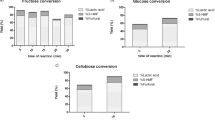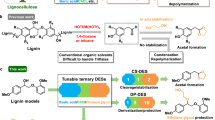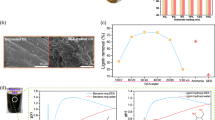Abstract
The increasing requirement to produce platform chemicals and fuels from renewable sources means advances in biocatalysis are rapidly becoming a necessity. Biomass is widely used in nature as a source of energy and as chemical building blocks. However, recalcitrance towards traditional chemical processes and solvents provides a significant barrier to widespread utility. Here, by optimizing enzyme solubility in ionic liquids, we have discovered solvent-induced substrate promiscuity of glucosidase, demonstrating an unprecedented example of homogeneous enzyme bioprocessing of cellulose. Specifically, chemical modification of glucosidase for solubilization in ionic liquids can increase thermal stability to up to 137 °C, allowing for enzymatic activity 30 times greater than is possible in aqueous media. These results establish that through a synergistic combination of chemical biology (enzyme modification) and reaction engineering (solvent choice), the biocatalytic capability of enzymes can be intensified: a key step towards the full-scale deployment of industrial biocatalysis.
This is a preview of subscription content, access via your institution
Access options
Access Nature and 54 other Nature Portfolio journals
Get Nature+, our best-value online-access subscription
$29.99 / 30 days
cancel any time
Subscribe to this journal
Receive 12 print issues and online access
$259.00 per year
only $21.58 per issue
Buy this article
- Purchase on Springer Link
- Instant access to full article PDF
Prices may be subject to local taxes which are calculated during checkout





Similar content being viewed by others
References
Ragauskas, A. J. et al. The path forward for biofuels and biomaterials. Science 311, 484–489 (2006).
Ragauskas, A. J. et al. Lignin valorization: improving lignin processing in the biorefinery. Science 344, 1246843 (2014).
Laskar, D. D. & Yang, B. Pathways for biomass derived lignin to hydrocarbon fuels. Biofuels Bioprod. Biorefin. 7, 602–626 (2013).
Blanch, H. W., Simmons, B. A. & Klein-Marcuschamer, D. Biomass deconstruction to sugars. Biotechnol. J. 6, 1086–1102 (2011).
Himmel, M. E. et al. Biomass recalcitrance: engineering plants and enzymes for biofuels production. Science 315, 804–807 (2007).
Griebenow, K. & Klibanov, A. M. On protein denaturation in aqueous−organic mixtures but not in pure organic solvents. J. Am. Chem. Soc. 118, 11695–11700 (1996).
Sheldon, R. A. & van Pelt, S. Enzyme immobilisation in biocatalysis: why, what and how. Chem. Soc. Rev. 42, 6223–6235 (2013).
Sheldon, R. A. & Pereira, P. C. Biocatalysis engineering: the big picture. Chem. Soc. Rev. 46, 2678–2691 (2017).
Smiglak, M. et al. Ionic liquids for energy, materials, and medicine. Chem. Commun. 50, 9228–9250 (2014).
Hallett, J. P. & Welton, T. Room-temperature ionic liquids: solvents for synthesis and catalysis. 2. Chem. Rev. 111, 3508–3576 (2011).
Brandt, A., Gräsvik, J., Hallett, J. P. & Welton, T. Deconstruction of lignocellulosic biomass with ionic liquids. Green Chem. 15, 550–583 (2013).
Xu, F. et al. Transforming biomass conversion with ionic liquids: process intensification and the development of a high-gravity, one-pot process for the production of cellulosic ethanol. Energy Environ. Sci. 9, 1042–1049 (2016).
Sheldon, R. A. Biocatalysis and biomass conversion in alternative reaction media. Chem. Eur. J. 22, 12984–12999 (2016).
Brogan, A. P. S. & Hallett, J. P. Solubilizing and stabilizing proteins in anhydrous ionic liquids through formation of protein–polymer surfactant nanoconstructs. J. Am. Chem. Soc. 138, 4494–4501 (2016).
George, A. et al. Design of low-cost ionic liquids for lignocellulosic biomass pretreatment. Green Chem. 17, 1728–1734 (2015).
Sørensen, A., Lübeck, M., Lübeck, P. S. & Ahring, B. K. Fungal beta-glucosidases: a bottleneck in industrial use of lignocellulosic materials. Biomolecules 3, 612–631 (2013).
Park, J. I. et al. A thermophilic ionic liquid-tolerant cellulase cocktail for the production of cellulosic biofuels. PLoS One 7, e37010 (2012).
Brogan, A. P. S., Siligardi, G., Hussain, R., Perriman, A. W. & Mann, S. Hyper-thermal stability and unprecedented re-folding of solvent-free liquid myoglobin. Chem. Sci. 3, 1839–1846 (2012).
Ab Rani, M. A. et al. Understanding the polarity of ionic liquids. Phys. Chem. Chem. Phys. 13, 16831–16840 (2011).
Zaks, A. & Klibanov, A. M. Enzymatic catalysis in organic media at 100 °C. Science 224, 1249 (1984).
Klibanov, A. M. Improving enzymes by using them in organic solvents. Nature 409, 241–246 (2001).
Clark, D. S. Characteristics of nearly dry enzymes in organic solvents: implications for biocatalysis in the absence of water. Philos. Trans. R. Soc. B 359, 1299–1307 (2004).
Brogan, A. P. S., Sharma, K. P., Perriman, A. W. & Mann, S. Enzyme activity in liquid lipase melts as a step towards solvent-free biology at 150 °C. Nat. Commun. 5, 5058 (2014).
Brogan, A. P. S., Sessions, R. B., Perriman, A. W. & Mann, S. Molecular dynamics simulations reveal a dielectric-responsive coronal structure in protein–polymer surfactant hybrid nanoconstructs. J. Am. Chem. Soc. 136, 16824–16831 (2014).
Gallat, F.-X. et al. A polymer surfactant corona dynamically replaces water in solvent-free protein liquids and ensures macromolecular flexibility and activity. J. Am. Chem. Soc. 132, 13168–13171 (2012).
Perriman, A. W. et al. Reversible dioxygen binding in solvent-free liquid myoglobin. Nat. Chem. 2, 622–626 (2010).
Jurick, W. M. II, Vico, I., Whitaker, B. D., Gaskins, V. L. & Janisiewicz, W. J. Application of the 2-cyanoacetamide method for spectrophotomeric assay of cellulase enzyme activity. Plant Pathol. J. 11, 38–41 (2012).
Lees, J. G., Miles, A. J., Wien, F. & Wallace, B. A. A reference database for circular dichroism spectroscopy covering fold and secondary structure space. Bioinformatics 22, 1955–1962 (2006).
Whitmore, L. & Wallace, B. A. Protein secondary structure analyses from circular dichroism spectroscopy: methods and reference databases. Biopolymers 89, 392–400 (2008).
Whitmore, L. & Wallace, B. A. DICHROWEB, an online server for protein secondary structure analyses from circular dichroism spectroscopic data. Nucleic Acids Res. 32, W668–W673 (2004).
Acknowledgements
The authors thank the EPSRC (Frontier Engineering Grant EP/K038648/1) for financial support. The authors also thank G. Siligardi, R. Hussain and T. Jaforvi at the Diamond Light Source for access to the B23 beamline, N. Terrill and A. Smith at the Diamond Light Source for access and support at the I22 beamline, W.-C. Tu for running HPLC samples and P. Carry for access to FTIR and dynamic light scattering.
Author information
Authors and Affiliations
Contributions
A.P.S.B. designed and performed the experiments, A.P.S.B. and J.P.H. wrote the manuscript, and L.B.-L. synthesized and characterized the ionic liquids. All authors discussed the results and commented on the manuscript.
Corresponding author
Ethics declarations
Competing interests
The authors declare no competing interests.
Additional information
Publisher’s note: Springer Nature remains neutral with regard to jurisdictional claims in published maps and institutional affiliations.
Supplementary information
Supplementary Information
Supplementary methods and experimental data
Rights and permissions
About this article
Cite this article
Brogan, A.P.S., Bui-Le, L. & Hallett, J.P. Non-aqueous homogenous biocatalytic conversion of polysaccharides in ionic liquids using chemically modified glucosidase. Nature Chem 10, 859–865 (2018). https://doi.org/10.1038/s41557-018-0088-6
Received:
Accepted:
Published:
Issue Date:
DOI: https://doi.org/10.1038/s41557-018-0088-6
This article is cited by
-
Enzyme immobilization on covalent organic framework supports
Nature Protocols (2023)
-
Chemical modification for improving catalytic performance of lipase B from Candida antarctica with hydrophobic proline ionic liquid
Bioprocess and Biosystems Engineering (2022)
-
Creation of stable water-free antibody based protein liquids
Communications Materials (2021)
-
Revealing the complexity of ionic liquid–protein interactions through a multi-technique investigation
Communications Chemistry (2020)
-
Biocatalytic strategies for the production of ginsenosides using glycosidase: current state and perspectives
Applied Microbiology and Biotechnology (2020)



